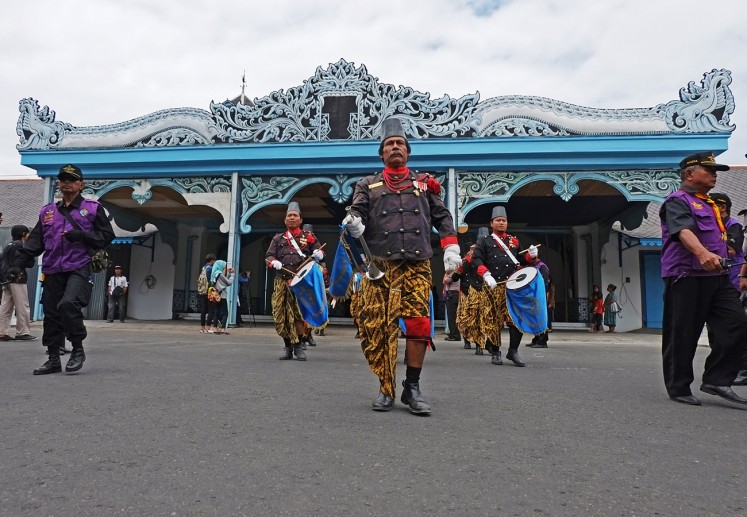Pono Wiguna: The man with the masks
JP/Simon SudarmanThe art of making masks is all about showing the elegance of teeth, says mask maker from Yogyakarta Pono Wiguna
Change text size
Gift Premium Articles
to Anyone

JP/Simon Sudarman
The art of making masks is all about showing the elegance of teeth, says mask maker from Yogyakarta Pono Wiguna.
Why? Because people tend to show their teeth to express joy when smiling, and because as our ancestors say that all situations in life must be faced with a smile and happiness.
“Whatever the problem, if faced with a smile and joy, it will be resolved by wisdom and lots of gratitude,” says Pono who has been a bekel sepuh (senior palace assistant) at the Yogyakarta Palace
since 1976.
Masks are quintessential to plays or performing arts, Pono believes. Their main purpose is to enhance the character of the dancer or puppet master.
That is the reason this 51-year-old father of two, who now lives in Diro, Pendowoharjo, Sewon Bantul, Yogyakarta, has been making classical masks since 1970.
“A good mask depends on the craftsperson’s ability to pour his strength of character into that mask so it becomes alive and can support the character the actor is playing.”
The ability of the mask maker depends on his experience in creating masks, not his age, he adds.
That’s why as a mask artist who has accepted his role in life and fully relies on it to eke out a living, he is grateful when his work is in demand.
His is wholeheartedly involved when creating masks, to make sure the mask appears to have a soul and is alive, so that with just a little movement during performances, the mask is able to create the right emotion, be it joy, sadness, or anger.
Pono studied arts and crafts at the Indonesian Art Institute (ISI). He then became a lecturer at the Indonesian Arts High School (STSI) in Surakarta from 1987 until 1990.
Classical masks cannot be separated from the development of the puppet arts in Indonesia, explains Pono. Puppets come in three kinds: purwa (classical puppets), madya (Javanese) and wusana.
Purwa puppets, which originally came from India, have always been very popular, while the madya (Javanese) puppets featuring characters such as Raden Panji Asmoro Bangun, Bancak, Doyok, Klono Sewandono, Prabu Lembu Amiluhur tend to be lesser known, and have not been well promoted.
“I intentionally engage in puppet mask-making to preserve the culture,” said Pono who received an award as a conservation artist in mask art from the Bantul regency, Yogyakarta, in 2009.
Because of his love for mask making, Pono together with artists such as Didik Nini Thowok and the late Sapto Raharjo, has even introduced his masks to other countries such as America, France and so on.
Many believe the masks are filled with meaning and reflect Indonesian society, depicting a minimum of three emotions illustrating human life, namely sadness, happiness, and anger.
As he inherited his mask-making skills from his grandfather Warno Wiguna, his handmade works of art became known as Warno Masks.
A mask takes him an average of two weeks to make, using wood from the jaranan tree grown in Purworejo, Central Java. It is no wonder his masks are sought by people from various countries such as the United States, the Netherlands, Britain, France, Belgium, Japan, when so much diligence goes into designing one mask.
“They don’t buy them for display or souvenirs, but for dances or plays.”
Pono uses the same wood as his grandfather, as it is light, strong and unappetizing to insects so his masks can last for decades.
Pono realized that to produce colors that did not fade quickly he had to preserve his grandfather’s ways by using natural coloring materials, such as the sap of the indigo tree for the color blue, or atal stone for yellow.
“The glue is made from animal fat. Using this process, the color [on the mask] is guaranteed to last hundreds of years and will not fade.”
The masks do not come cheap, given the labor of love that has gone into making them. Apart from the long process of manufacturing, the work also requires persistence, patience, care and dedication to the task.
“I decide the price according to my feelings and taste…but when I feel my artistic sense and creativity do not match the money I’m being offered, then, no, I will not sell.
“I’ll sell when I get bored or if there is something else to replace it,” he chuckled as he mentioned the average price for one of his masks was Rp 1 million (US$100).









